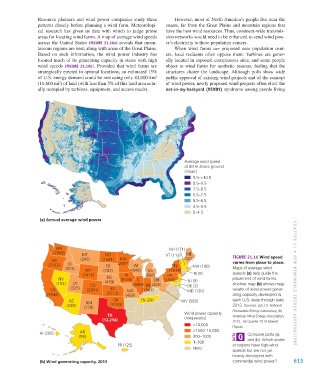Page 616 - Environment: The Science Behind the Stories
P. 616
Resource planners and wind power companies study these However, most of North America’s people live near the
patterns closely before planning a wind farm. Meteorologi- coasts, far from the Great Plains and mountain regions that
cal research has given us data with which to judge prime have the best wind resources. Thus, continent-wide transmis-
areas for locating wind farms. A map of average wind speeds sion networks would need to be enhanced to send wind pow-
across the United States (Figure 21.16a) reveals that moun- er’s electricity to these population centers.
tainous regions are best, along with areas of the Great Plains. When wind farms are proposed near population cent-
Based on such information, the wind power industry has ers, local residents often oppose them. Turbines are gener-
located much of its generating capacity in states with high ally located in exposed, conspicuous sites, and some people
wind speeds (Figure 21.16b). Provided that wind farms are object to wind farms for aesthetic reasons, feeling that the
strategically erected in optimal locations, an estimated 15% structures clutter the landscape. Although polls show wide
of U.S. energy demand could be met using only 43,000 km public approval of existing wind projects and of the concept
2
2
(16,600 mi ) of land (with less than 5% of this land area actu- of wind power, newly proposed wind projects often elicit the
ally occupied by turbines, equipment, and access roads). not-in-my-backyard (NIMby) syndrome among people living
Average wind speed
at 80 m above ground
(m/sec)
9.5–>10.5
8.5–9.5
7.5–8.5
6.5–7.5
5.5–6.5
4.5–5.5
0–4.5
(a) Annual average wind power
WA NH (171)
(2808) MT ND VT (119) ME
OR (645) (1681) MN (431) Figure 21.16 Wind speed
varies from place to place.
(3153) ID SD (2987) WI NY MA (100)
(973) WY (783) (648) MI (1638) Maps of average wind
(1410) IA (988) PA RI (9) speeds (a) help guide the
NV NE (5133) IL OH (1340) NJ (9) placement of wind farms.
(152) UT CO (459) (3568) IN (428) DE (2) Another map (b) shows meg- CHAPTER 21 • N E w R ENE wA bl E E NER gy AlTERN AT iv E s
CA (325) (2301) KS MO (1543) MD (120) awatts of wind-power-gener-
(5544) (2713) (459) ating capacity developed in
AZ NM OK TN (29) WV (583) each U.S. state through early
(238) (778) (3134) 2013. Sources: (a) U.S. National
TX Wind power capacity Renewable Energy Laboratory; (b)
American Wind Energy Association,
(12,214) (megawatts) 2013. 1st Quarter 2013 Market
>10,000 Report.
HI (206) AK >1000–10,000 Compare parts (a)
(59) 300–1000 and (b). Which states
1–300
PR (125) or regions have high wind
None
speeds but are not yet
heavily developed with
(b) Wind generating capacity, 2013 commercial wind power? 615
M21_WITH7428_05_SE_C21.indd 615 12/12/14 4:29 PM

